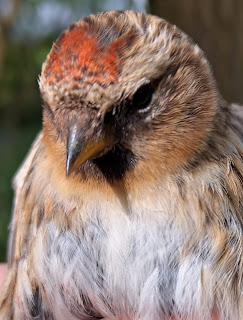This last few weeks have been crazy!! Every now and then we have a ''Siskin Year'', when for whatever reason, many more Siskins visit our gardens and feeding stations than is normal. The last time this happened was about 15 years ago.
We're not really certain what causes it but it must be something to do with the availability of their natural food ( Alder cone seeds), and the size of the population/success of breeding. It appears that the result is a mass emigration of these birds in all directions, with lots coming to the UK.
The result has been that we have ringed around 2000 in the last few weeks!! But it remained a mystery where they had all come from. Our only hint was a bird which had been ringed near Inverness, which we caught near the start of the invasion.
However, in the last 2 days we have ringed almost 150 new Siskin, but we have also controlled 4 birds already ringed by others. One is a British ringed bird, but the other 3 are very exciting........
You can just make out ND in the top line and SK in the middle line. The top line tells us the bird was ringed in POLAND, and the ringing centre is in GDANSK !! Looking forward to hearing more deatils in due course. The next one.........
Not quite as clear, but the middle line is HIDENSEE and the bottom line is GERMANIA--so this bird was ringed in Germany!! and finally
The middle line here says PRAHA--so this bird was ringed in the Czech Republic!!
It looks like this invasion is from birds in the central European area, and it's going to be really interesting to see exactly where they have come from--and how many more have been caught throughout the UK.
On a much more local note--but nonetheless valuable data, we re-trapped a Blue Tit a couple of days ago, and thought the number looked familiar. On checking we found that we originally ringed it on 14th December 2019, at Brewood Park Farm. Then again at the same site on 25th April 2023, and now on 23rd March 2024. A survivor!!
More news soon--especially when I find out where the Siskins came from.

















